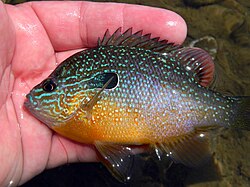| Longear sunfish | |
|---|---|

| |
| Scientific classification | |
| Domain: | Eukaryota |
| Kingdom: | Animalia |
| Phylum: | Chordata |
| Class: | Actinopterygii |
| Order: | Perciformes |
| Family: | Centrarchidae |
| Genus: | Lepomis |
| Species: | L. megalotis
|
| Binomial name | |
| Lepomis megalotis (Rafinesque, 1820)
| |
| Synonyms[2] | |
|
Icthelis megalotis Rafinesque, 1820 | |

The longear sunfish (Lepomis megalotis) is a freshwater fish in the sunfish family, Centrarchidae, of order Perciformes. It is native to the area of eastern North America stretching from the Great Lakes down to northeastern Mexico.[3] The longear sunfish reaches a maximum recorded length of about 24 cm (9.4 in), with a maximum recorded weight of 790 g (1.74 lb).[4] Most do not live beyond six years.[4] The longear sunfish is quite colorful, with an olive to rusty-brown back, bright orange belly and vermiculate blue-green bars on the sides of its head, the latter two features most pronounced in breeding males. A unique characteristic of longear sunfish is their elongated operculum flap, giving an appearance of a "long ear". It is black and often has a white margin. The pectoral fin is relatively short and would not reach the snout if it were reflected anteriorly. In breeding males, iridescent blue spots develop on the dorsum and sides and the fin membranes turn orange in all fins except the ventral ones, which may be blue to black,[4] and the pectoral ones.[4][5][6] Lepomis megalotis can be distinguished from closely related dollar sunfish L. marginatus by a greater number of cheek scale rows, by having one to two additional pectoral fin rays and by the slope of the opercular flap, which is distinctly upward in L. marginatus but is closer to horizontal in males of L. megalotis, although female and subadult L. megalotis may have upward slanting opercular flaps.[4]
The species prefers densely vegetated, shallow waters in lakes, ponds, and sluggish streams. Its diet can include insects, aquatic invertebrates, and small fish. Avoiding strong currents, longear sunfish are usually present in small to moderate flowing streams, rivers, and reservoirs.[7] The genus Lepomis has a well-characterized mating behavior where parental care is done by the male. The male makes and defends the nest, and fans the eggs to remove silt and other debris until the larvae hatch. Some longear females produce 4,000 eggs.[8] They spawn in groups but do not form large colonies.
Longear sunfish are better at getting food in moving waters than still waters; this may explain why they are more abundant in streams than lakes. For the most part, longear sunfish are active during the day and inactive at night.[8] There are very few conservation acts currently being performed in order to maintain the distribution and abundance of this species.[9]
- ^ NatureServe; Lambarri Martínez, C.; Espinosa Pérez, H. (2019). "Lepomis megalotis". IUCN Red List of Threatened Species. 2019: e.T62216A130014171. doi:10.2305/IUCN.UK.2019-2.RLTS.T62216A130014171.en. Retrieved 20 November 2021.
- ^ Froese, Rainer; Pauly, Daniel (eds.). "Lepomis megalotis". FishBase. December 2019 version.
- ^ Berra, Tim and Gunning, Gerald (1972). "Seasonal movement and home range of the longear sunfish, Lepomis megalotis (rafinesque) in Louisiana". American Midland Naturalist, 88 (2): 368–375.
- ^ a b c d e Bonner, T (2007) "Lepomis megalotis: Longear sunfish" Texas Freshwater Fishes, Texas State University. Retrieved 2 June 2024.
- ^ Mettee, Maurice F.; O'Neil, Patrick E.; Pierson, J. Malcolm (2024) [Originally published 1996 in Fishes of Alabama and the Mobile Basin]. "Longear Sunfish". Outdoor Alabama. Alabama Department of Conservation and Natural Resources. Retrieved 2 June 2024.
- ^ "Longear Sunfish". Missouri Department of Conservation. Conservation Commission of Missouri. 2024. Retrieved 2 June 2024.
- ^ Mullaney, M (2003) "Lepomis megalotis" Animal Diversity Web, University of Michigan. Accessed 24 November 2013.
- ^ a b Witt, Arthur (1954) "Spawning and behavior of the longear sunfish, lepomis megalotis megalotis". Copeia, 3: 188–190.
- ^ Lyons J (2013) "Longear sunfish (lepomis megalotis)" Wisconsin Department of Natural Resources. Updated 18 November 2013. Retrieved 25 November 2013.
